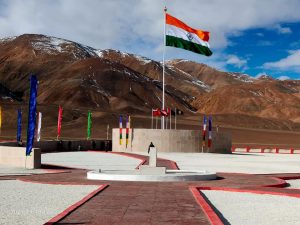Indian and Chinese military commanders met on March 11 for the 15th round of talks on disengagement of troops from “friction points” along the Line of Actual Control (LAC) in Ladakh.
The talks, which were held at the Chushul-Moldo border meeting point on the Indian side of the LAC, ended without yielding a breakthrough.
This was the first meeting between Indian and Chinese officials since Russia’s invasion of Ukraine, which many in India’s security establishment fear could have implications for the border dispute with China.
Relations between India and China have deteriorated significantly since May 2020, when Chinese soldiers ingressed into the Indian side of the disputed border in Ladakh.
Fifteen rounds of talks have taken place over the last 22 months. These have resulted in disengagement of troops from Galwan Valley (July 2020), the north and south banks of Pangong Tso (February 2021) and Gogra Post (August 2021). Agreement on pullback of troops from three other “friction points” – Hot Springs, Demchok, and Depsang Plains – remains elusive.
Hot Springs or Patrolling Point (PP) 15, which lies close to the Chang Chenmo river in the Galwan sub-sector of the LAC, was high on the agenda of the 15th round of talks.
Indian analysts cite military sources as describing Hot Springs as “low hanging fruit” on which a settlement is within reach.
Apparently, India and China had agreed on disengagement from Hot Springs in July 2020 and although the process of pulling back troops began, the Chinese did not complete the process. As a result the two sides have “two small groups of soldiers camped opposite each other at PP 15.”
Apparently, “a broad understanding on resolution” of the conflict at Hot Springs was reached during the 14th round of talks in January. That feed the heightened expectation that an agreement on Hot Springs would be achieved at the 15th round.
However, that did not happen.
Although no breakthrough was achieved at the 15th round, the two sides issued a joint statement at the end of the talks, which is itself an achievement, considering that the 13th round in October last year ended in angry recriminations and separate statements in which the two sides slammed each other.
This time around, the statement seems positive. The two sides carried “forward their discussions from the previous round” of talks held on January 12, 2022. They agreed to maintain security and stability on the ground in the interim and to continue “dialogue via military and diplomatic channels to reach a mutually acceptable resolution at the earliest.”
However, three rounds of talks have not yielded agreement on disengagement of troops. The last time such an agreement was reached was at the 12th round in August 2021, when the two sides agreed to pull back from Gogra Post.
Contrary to reports that reaching a settlement on disengagement at Hot Springs will be easy, this is proving to be a stumbling block. Former military officials say that it is an area that is important to both sides.
“Low hanging fruit? The geography of the area makes it as important as Depsang Plains, if not more. Recall in 1959 the first clash took place here!” Harcharanjit Singh Panag, a retired lieutenant general in the Indian Army tweeted.
Indian analysts are saying that the Chinese have categorically refused to discuss disengagement at Depsang. Chinese troops are said to have occupied the Y-junction on the Indian side of the LAC, cutting off Indian soldiers’ access to five patrolling points in this highly strategic area. The Chinese have pitched a few tents on the Indian side in Demchok too and have refused to pull back. Given the immense strategic value of Hot Springs, Demchok, and Depsang, the People’s Liberation Army has perhaps dug in its heels at the talks.
It does seem that a decision on disengagement from Hot Springs, Depsang, and Demchok will have to be made at the highest political level, as the current talks at the level of corps commanders has been unable to break the stalemate.
Meanwhile, Indian analysts are drawing attention to the implications of the Ukraine crisis for India’s defense preparedness and the situation at the LAC. While some are not ruling out the possibility of the Chinese using the international community’s preoccupation with the crisis in Eastern Europe to quietly ingress deeper into Indian territory, cross the LAC at other strategic points and sectors, and consolidate its position in places like Depsang, others are pointing to the longer-term impact on Russian military supplies to India.
India’s military hardware is majorly dependent on Russia. Will supplies to India be hit by U.S. sanctions on Moscow? Should Russia’s invasion of Ukraine be prolonged, its capacity to meet Indian defense demands will be undermined. Moreover, Moscow’s dependence on China for diplomatic and military support will grow.
Should the border conflict with China escalate in the coming months, India may not get the Russian support it has always received. India could find itself alone in dealing with China.
The stalemate at the negotiation table is reason for serious Indian concern.

































